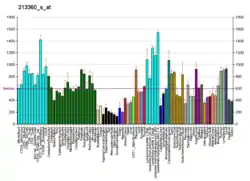POM121
Nuclear envelope pore membrane protein POM 121 is a protein that in humans is encoded by the POM121 gene.[5][6][7] Alternatively spliced variants that encode different protein isoforms have been described but the full-length nature of only one has been determined.[8]
Function
The nuclear envelope creates distinct nuclear and cytoplasmic compartments in eukaryotic cells. It consists of two concentric membranes perforated by nuclear pores, large protein complexes that form aqueous channels to regulate the flow of macromolecules between the nucleus and the cytoplasm. These complexes are composed of at least 100 different polypeptide subunits, many of which belong to the nucleoporin family. This gene encodes a member of the FG-repeat-containing nucleoporins. The protein encoded by this gene is an integral membrane protein that localizes to the central spoke ring complex and participates in anchoring the nuclear pore complex to the nuclear envelope.[8]
Antibodies against this protein can be used to identify the nuclear envelope in immunofluorescence experiments.[9]
References
- GRCh38: Ensembl release 89: ENSG00000196313 - Ensembl, May 2017
- GRCm38: Ensembl release 89: ENSMUSG00000053293 - Ensembl, May 2017
- "Human PubMed Reference:". National Center for Biotechnology Information, U.S. National Library of Medicine.
- "Mouse PubMed Reference:". National Center for Biotechnology Information, U.S. National Library of Medicine.
- Hallberg E, Wozniak RW, Blobel G (Aug 1993). "An integral membrane protein of the pore membrane domain of the nuclear envelope contains a nucleoporin-like region". J Cell Biol. 122 (3): 513–21. doi:10.1083/jcb.122.3.513. PMC 2119659. PMID 8335683.
- Ishikawa K, Nagase T, Suyama M, Miyajima N, Tanaka A, Kotani H, Nomura N, Ohara O (Dec 1998). "Prediction of the coding sequences of unidentified human genes. X. The complete sequences of 100 new cDNA clones from brain which can code for large proteins in vitro". DNA Res. 5 (3): 169–76. doi:10.1093/dnares/5.3.169. PMID 9734811.
- Funakoshi T, Maeshima K, Yahata K, Sugano S, Imamoto F, Imamoto N (Oct 2007). "Two distinct human POM121 genes: requirement for the formation of nuclear pore complexes". FEBS Lett. 581 (25): 4910–6. doi:10.1016/j.febslet.2007.09.021. PMID 17900573. S2CID 12819086.
- "Entrez Gene: POM121 POM121 membrane glycoprotein (homo sapiens)".
- Kihlmark M, Imreh G, Hallberg E (October 2001). "Sequential degradation of proteins from the nuclear envelope during apoptosis". J. Cell Sci. 114 (Pt 20): 3643–53. PMID 11707516.
Further reading
- Bodoor K, Shaikh S, Enarson P, et al. (1999). "Function and assembly of nuclear pore complex proteins". Biochem. Cell Biol. 77 (4): 321–9. doi:10.1139/bcb-77-4-321. PMID 10546895.
- Kipersztok S, Osawa GA, Liang LF, et al. (1995). "POM-ZP3, a bipartite transcript derived from human ZP3 and a POM121 homologue". Genomics. 25 (2): 354–9. doi:10.1016/0888-7543(95)80033-I. PMID 7789967.
- Fouchier RA, Meyer BE, Simon JH, et al. (1998). "Interaction of the Human Immunodeficiency Virus Type 1 Vpr Protein with the Nuclear Pore Complex". J. Virol. 72 (7): 6004–13. doi:10.1128/JVI.72.7.6004-6013.1998. PMC 110405. PMID 9621063.
- Daigle N, Beaudouin J, Hartnell L, et al. (2001). "Nuclear pore complexes form immobile networks and have a very low turnover in live mammalian cells". J. Cell Biol. 154 (1): 71–84. doi:10.1083/jcb.200101089. PMC 2196857. PMID 11448991.
- Strausberg RL, Feingold EA, Grouse LH, et al. (2003). "Generation and initial analysis of more than 15,000 full-length human and mouse cDNA sequences". Proc. Natl. Acad. Sci. U.S.A. 99 (26): 16899–903. doi:10.1073/pnas.242603899. PMC 139241. PMID 12477932.
- Hillier LW, Fulton RS, Fulton LA, et al. (2003). "The DNA sequence of human chromosome 7". Nature. 424 (6945): 157–64. doi:10.1038/nature01782. PMID 12853948.
- Ota T, Suzuki Y, Nishikawa T, et al. (2004). "Complete sequencing and characterization of 21,243 full-length human cDNAs". Nat. Genet. 36 (1): 40–5. doi:10.1038/ng1285. PMID 14702039.
- Eriksson C, Rustum C, Hallberg E (2004). "Dynamic properties of nuclear pore complex proteins in gp210 deficient cells". FEBS Lett. 572 (1–3): 261–5. doi:10.1016/j.febslet.2004.07.044. PMID 15304359. S2CID 22760247.
- Rual JF, Venkatesan K, Hao T, et al. (2005). "Towards a proteome-scale map of the human protein-protein interaction network". Nature. 437 (7062): 1173–8. doi:10.1038/nature04209. PMID 16189514. S2CID 4427026.
- Lim J, Hao T, Shaw C, et al. (2006). "A protein-protein interaction network for human inherited ataxias and disorders of Purkinje cell degeneration". Cell. 125 (4): 801–14. doi:10.1016/j.cell.2006.03.032. PMID 16713569. S2CID 13709685.
- Olsen JV, Blagoev B, Gnad F, et al. (2006). "Global, in vivo, and site-specific phosphorylation dynamics in signaling networks". Cell. 127 (3): 635–48. doi:10.1016/j.cell.2006.09.026. PMID 17081983. S2CID 7827573.






